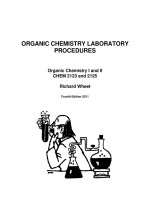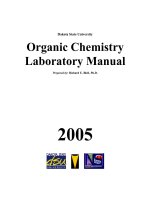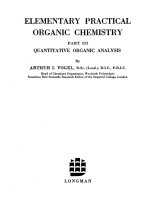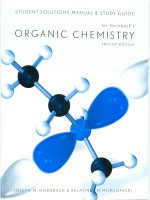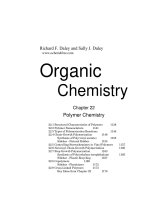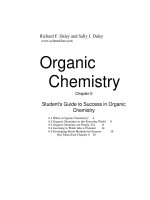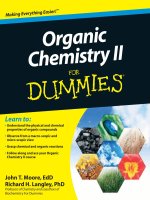Organic chemistry
Bạn đang xem bản rút gọn của tài liệu. Xem và tải ngay bản đầy đủ của tài liệu tại đây (41.16 MB, 1,240 trang )
www.pdfgrip.com
Organic Chemistry:
Structure, Mechanism, and Synthesis
www.pdfgrip.com
This Page Intentionally left blank
www.pdfgrip.com
Organic Chemistry:
Structure, Mechanism, and Synthesis
Robert J. Ouellette
Professor Emeritus, Department
of Chemistry, The Ohio State University
And
J. David Rawn
Professor Emeritus,
Towson University
AMSTERDAM • BOSTON • HEIDELBERG • LONDON • NEW YORK • OXFORD
PARIS • SAN DIEGO • SAN FRANCISCO • SINGAPORE • SYDNEY • TOKYO
www.pdfgrip.com
Elsevier
525 B Street, Suite 1900, San Diego, CA 92101-4495, USA
225 Wyman Street, Waltham, MA 02451, USA
Copyright © 2014 Elsevier Inc. All rights reserved.
No part of this publication may be reproduced, stored in a retrieval system or transmitted in any
form or by any means electronic, mechanical, photocopying, recording or otherwise without the
prior written permission of the publisher.
Permissions may be sought directly from Elsevier’s Science & Technology Rights Department in
Oxford, UK: phone (+44) (0) 1865 843830; fax (+44) (0) 1865 853333; email: permissions@
elsevier.com. Alternatively you can submit your request online by visiting the Elsevier web site at
and selecting Obtaining permission to use Elsevier material.
Notice
No responsibility is assumed by the publisher for any injury and/or damage to persons or
property as a matter of products liability, negligence or otherwise, or from any use or operation
of any methods, products, instructions or ideas contained in the material herein. Because of rapid
advances in the medical sciences, in particular, independent verification of diagnoses and drug
dosages should be made.
Library of Congress Cataloging-in-Publication Data
Rawn, J. David, 1944Organic chemistry / J. David Rawn, Robert J. Ouellette. – First edition.
pages cm
Includes index.
ISBN 978-0-12-800780-8
1. Chemistry, Organic–Textbooks. I. Ouellette, Robert J., 1938- II. Title.
QD251.3.R39 2014
547–dc23
British Library Cataloguing in Publication Data
A catalogue record for this book is available from the British Library
For information on all Elsevier publications
visit our web site at store.elsevier.com
Printed and bound in China
14 15 16 17 18 10 9 8 7 6 5 4 3 2 1
ISBN: 978-0-12-800780-8
2013050560
www.pdfgrip.com
To our families
Verweile doch, du bist so schön.
—Johann Wolfgang von Goethe, Faust
www.pdfgrip.com
This Page Intentionally left blank
www.pdfgrip.com
Contents
Acknowledgments
Preface
xxxiii
xxxv
Chapter 1 structure and bonding in organic compounds
Table of Contents
1.1 Brief review of atomic structure
Page
1
Atomic Structure
Atomic Orbitals
Valence Shell Electrons
1
1.2 Atomic properties
3
Atomic Radius
3
Electronegativity
3
1.3 ionic and covalent bonds
4
Ionic Bonds
Covalent Bonds
Structural Formulas
Multiple Covalent Bonds
Polar Covalent Bonds
4
1.4 strategies for writing Lewis structures
1.5 formal charge
1.6 molecular geometry
8
2
3
5
6
6
7
10
11
Bond Lengths
Drawing Structures
11
1.7 resonance structures
12
Nonequivalent Resonance Structures
13
1.8 valence shell electron Pair repulsion theory
1.9 dipole moments
15
Determining Charge Separation
Bond Polarity and Molecular Geometry
16
1.10 molecular orbital theory
18
Molecular Orbitals
18
1.11 The hydrogen molecule
1.12 bonding in carbon compounds
19
Orbital Hybridization
21
1.13 sp3 hybridization of carbon in methane
1.14 sp3 hybridization of carbon in ethane
1.15 sp2 hybridization of carbon in ethene
1.16 sp hybridization of carbon in ethYne
1.17 effect of hybridization on bond length and bond strength
1.18 hybridization of nitrogen
1.19 hybridization of oxygen
21
12
16
17
20
22
23
25
27
27
30
vii
www.pdfgrip.com
Summary of Orbital Hybridization and Its Relation to VSEPR Theory
32
exercises
33
Chapter 2 Part I: Functional Groups and Their Properties
Table of Contents
2.1 INTRODUCTION TO FUNCTIONAL GROUPS: HYDROCARBONS AND HALOALKANES
Page
41
Hydrocarbons
Haloalkanes
41
2.2 FUNCTIONAL GROUPS THAT CONTAIN OXYGEN
43
Carbon–Oxygen Single Bonds in Alcohols and Ethers
Carbon–Oxygen Double Bonds in Aldehydes and Ketones
Carbon–Oxygen Bonds in Carboxylic Acids and Esters
43
2.3 FUNCTIONAL GROUPS THAT CONTAIN NITROGEN
2.4 FUNCTIONAL GROUPS THAT CONTAIN sulfur
2.5 STRUCTURAL FORMULAS
2.6 BOND-LINE STRUCTURES
45
Recognizing Structural Features in Complex Molecules
50
2.7 isomers
52
Nomenclature
54
Part II: Identification of Functional Groups by infrared
spectroscopy
2.8 SPECTROSCOPY
2.9 infrared sPECTROSCOPY
42
43
44
47
48
49
55
57
The Relation of Vibrational Frequencies and the Masses of Bonded Atoms
57
2.10 IDENTIFYING HYDROCARBONS
2.11 IDENTIFYING OXYGEN-CONTAINING COMPOUNDS
58
The Carbonyl Group
Alcohols and Ethers
Carboxylic Acids
Esters
Carboxylic Acid Anhydrides
61
2.12 IDENTIFYING nitroGEN-CONTAINING COMPOUNDS
64
Amines
Nitriles
65
2.13 BENDING DEFORMATIONS
66
Alkenes
Bending Modes in Aromatic Compounds
66
end-of-chapter exercises
69
61
62
63
63
64
66
66
Chapter 3 Introduction to organic reaction mechanisms
Table of Contents
3.1 acid-base reactions
viii
Page
75
www.pdfgrip.com
Brønsted-Lowry Acids and Bases
Lewis Acids
75
3.2 CHEMICAL EQUILIBRIUM AND EQUILIBRIUM CONSTANTS
78
Le Chatelier’s Principle
79
3.3 pH AND pK VALUES
80
Ka and pKa
Kb and pKb
Applying pKa Values in Organic Acid-Base Reactions
80
76
81
82
3.4 EFFECT OF STRUCTURE ON ACIDITY
84
Effect of Periodic Trends on Acidity and Basicity
Effect of Resonance on Acidity and Basicity
Inductive Effects
Effect of Hybridization on Acidity
84
3.5 STANDARD FREE ENERGY CHANGES IN CHEMICAL REACTIONS
86
The Standard Free Energy Change and the Equilibrium Constant
86
3.6 ENTHALPY CHANGES IN CHEMICAL REACTIONS
3.7 BOND DISSOCIATION ENERGIES
88
Effect of Electronegativity on Bond Energies
Effect of Hybridization on Bond Energies
Effect of Multiple Bonds on Bond Energies
89
3.8 INTRODUCTION TO REACTION MECHANISMS
90
Concerted and Multistep Reactions
Types of Bond Cleavage
90
3.9 STRUCTURES AND STABILITIES OF CARBON RADICALS, CARBOCATIONS,
AND CARBANIONS
91
Carbocations
Carbon Radicals
Methyl Radical
Carbanions
91
3.10 FACTORS THAT INFLUENCE REACTION RATES
94
The Effect of Structure on Reactivity
The Effect of Reactant Concentration on Reaction Rates
The Effect of Temperature on Reaction Rates
The Effect of Catalysts on Reaction Rates
94
3.11 reaction rate theory
97
Reaction Coordinate Diagrams
Reaction Coordinate Diagrams and Reaction Mechanisms
Catalysis
Transition State Structure: The Hammond Postulate
97
3.12 STABILITY AND REACTIVITY
end-of-chapter exercises
84
85
85
89
90
90
90
93
93
93
95
95
96
98
100
101
102
103
ix
www.pdfgrip.com
Chapter 4 Alkanes and Cycloalkanes: Structures and reactions
Table of Contents
Page
4.1 CLASSES OF HYDROCARBONS
111
4.2 alkanes
112
Classification of Carbon Atoms
113
4.3 NOMENCLATURE OF ALKANES
114
IUPAC Rules for Naming Alkanes
Names of Alkyl Groups
114
4.4 CONFORMATIONS OF ALKANES
119
Conformations of Ethane
Newman Projection Formulas
Barrier to Rotation in Ethane
Confirmations of Propane
Conformations of Butane
Conformations of Acyclic Compounds
Conformations and Biological Activity
119
4.5 cyclolakanes
126
Geometric Isomerism
Nomenclature of Cycloalkanes
Relative Stabilities of Cycloalkanes
126
4.6 CONFORMATIONS OF CYCLOALKANES
131
Cyclopropane
Cyclobutane
Cyclopentane
Cyclohexane
Drawing Cyclohexane Rings
131
4.7 CONFORMATIONAL MOBILITY OF CYCLOHEXANE
134
Chair-Chair Interconversion of Cyclohexane Rings
Boat Conformation of Cyclohexane
Twist Boat Conformation of Cyclohexane
134
4.8 MONOSUBSTITUTED CYCLOHEXANES
4.9 DiSUBSTITUTED CYCLOHEXANES
136
cis- and trans-1,4-Dimethylcyclohexanes
cis- and trans-1,2-Dimethylcyclohexanes
Compounds with Two Different Substituents
137
4.10 polycyclic molecules
141
cis- and trans-Decalin
The Steroid Ring System
Human Physiological Effects of steroids
141
4.11 PHYSICAL PROPERTIES OF ALKANEs
142
van der Waals Forces (London Forces)
Boiling Points of Alkanes
Solubility of Alkanes
142
x
116
120
120
121
122
124
125
128
129
131
132
132
133
134
135
137
139
140
141
142
143
144
www.pdfgrip.com
Densities of Alkanes
144
4.12 STABILITIES OF ALKYL RADICALS
145
Bond Dissociation Energies of Alkanes
145
4.13 CHLORINATION OF AN ALKANE—A RADICAL REACTION
148
Regioselectivity of Alkane Halogenation
148
Reactivity and Statistical Factors
150
Enthalpy Changes for Halogenation Reactions
151
Activation Energy for Halogenation
152
Reactivity and Selectivity
153
EXERCISES
155
Chapter 5 Alkenes Structures and properties
Table of Contents
Page
5.1 ALKENES
163
5.2 STRUCTURE AND bonding OF ALKENES
164
Bond Length and Bond Energies
Classification of Alkenes
165
5.3 UNSATURATION NUMBER
5.4 GEOMETRIC ISOMERISM
5.5 E,Z NOMENCLATURE OF GEOMETRICAL ISOMERS
167
Sequence Rules
171
5.6 NOMENCLATURE OF ALKENES
173
Common Names of Alkenyl Groups
IUPAC Names of Alkenes
173
5.7 PHYSICAL PROPERTIES OF ALKENES
175
Density of Alkenes
Polarity of Alkenes
Boiling Points of Alkenes
175
5.8 stability of ALKENES
5.9 reduction OF ALKENES
177
Regioselectivity of Catalytic Hydrogenation
Homogenous Catalytic Hydrogenation
180
5.10 mechanism of catalytic hydrogenation
181
Stereochemistry of Hydrogenation
Stereoselectivity of Hydrogenation
181
5.11 HEATS OF HYDROGENATION OF ALKENES
183
Structural Effects on Heats of Hydrogenation
183
EXERCISES
185
166
168
170
173
175
176
178
180
181
Chapter 6 Alkenes: Addition reactions
Table of Contents
Page
6.1 CHARACTERISTICS OF ADDITION REACTIONS
195
Stereochemistry of Addition Reactions
196
xi
www.pdfgrip.com
Carbocations in Addition Reactions
196
6.2 ADDITION OF HYDROGEN HALIDES TO ALKENES
197
Regiospecificity of Hydrogen Halide Addition
Markovnikov’s Rule
Synthesis of Alkyl Chlorides
197
6.3 THE MECHANISTIC BASIS OF MARKOVNIKOV’S RULE
199
Hammond Postulate and Electrophilic Addition
200
6.4 CARBOCATION REARRANGEMENT REACTIONS
6.5 HYDRATION OF ALKENES
201
Reversibility of Hydration
204
6.6 ADDITION OF HALOGENS
205
Stereochemistry of Halogen Addition
Mechanism of Halogen Addition
Formation of Halohydrins
206
6.7 ADDITION OF CARBENES
208
Formation of Dichlorocarbene
Stereospecificity of Carbene Addition Reaction
Carbenoid Species
208
6.8 EPOXIDATION OF ALKENES
210
Mechanism of Epoxidation
211
6.9 DIHYDROXYLATIN OF ALKENES
212
Dihydroxylation with Osmium Tetraoxide
Mechanism of Syn Dihydroxylation
213
6.10 OZONOLYSIS OF ALKENES
214
Mechanism of Ozonolysis
Reductive and Oxidative Workup
214
exercises
217
198
199
204
206
207
209
209
213
215
Chapter 7 alkynes
Table of Contents
Page
7.1 OCCURRENCE AND USES OF ALKYNES
223
7.2 STRUCTURE AND PROPERTIES OF ALKYNES
224
Classification of Alkynes
Hybridization, Bond Length, and Bond Energies in Alkynes
Physical Properties of Alkynes
Chemical Properties of Alkynes
224
7.3 IUPAC NAMES OF ALKYNES
7.4 ACIDITY OF TERMINAL ALKYNES
7.5 HYDROGENATION OF ALKYNES
227
Syn Addition of Hydrogen
Anti Addition of Hydrogen
Mechanism of Anti Addition
229
xii
224
225
226
228
228
229
230
www.pdfgrip.com
7.6 ELECTROPHILIC ADDITION REACTIONS
231
Addition of Hydrogen Halides
Addition of Halogens
Hydration of Alkynes
231
7.7 SYNTHESIS OF ALKYNES
234
Elimination Reactions of Dihalides
Alkylation of Alkynes
234
exercises
236
232
233
235
Chapter 8 stereochemistry
Table of Contents
8.1 STEREOISOMERS
Page
8.2 MIRROR IMAGE OBJECTS, MIRROR IMAGE MOLECULES, AND CHIRALITY
241
Chiral Molecules
242
Mirror Image Isomers
243
Properties of Enantiomers
245
8.3 OPTICAL ACTIVITY
246
Plane-Polarized Light
246
Specific Rotation
246
Circularly Polarized Light and Optical Rotation
247
Optical Purity
248
8.4 FISCHER PROJECTION FORMULAS
250
8.5 ABSOLUTE CONFIGURATION
251
R,S Configurations: The Kahn-Ingold-Prelog System of Configurational Nomenclature
252
Priority Rules
252
8.6 MOLECULES WITH TWO (OR MORE) STEREOGENIC CENTERS
254
Nonequivalent Stereogenic Centers
255
Nomenclature of Diastereomers
256
Equivalent Stereogenic Centers
257
8.7 Cyclic Molecules with Stereogenic Centers
260
Cyclic Structures with One Stereogenic Center
Cyclic Structures with Two Stereogenic Centers: Disubstituted Cyclobutanes
Cyclic Structures with Two Stereogenic Centers: Dimethyl Cyclohexanes
Chirality and Our Senses of Taste and Smell
260
8.8 SEPARATION OF ENANTIOMERS
266
General Principles
Chiral Chromatography
266
8.9 CHEMICAL REACTIONS AT STEREOGENIC CENTERS
268
Reactions of Chiral Molecules That Do Not Occur at the Stereogenic Center
Preview: Stereochemistry of a Substitution Reaction at a Stereogenic Center
Stereochemistry of a Free Radical Reaction
268
241
261
261
265
267
268
269
xiii
www.pdfgrip.com
8.10 REACTIONS THAT PRODUCE STEREOGENIC CENTERS
270
Stereochemistry of Markovnikov Addition to Alkenes
Stereochemistry of Alkene Bromination
270
8.11 REACTIONS THAT FORM DIASTEREOMERS
8.12 PROCHIRAL CENTERS
exercises
273
271
274
276
Chapter 9 Haloalkanes and alcohols Introduction to
Nucleophilic Substitution and Elimination Reactions
Table of Contents
Page
9.1 FUNCTIONALIZED HYDROCARBONS
287
Classification of Haloalkanes and Alcohols
Interconversion of Haloalkanes and Alcohols
287
9.2 NOMENCLATURE OF HALOALKANES
288
IUPAC Names of Haloalkanes
289
9.3 NOMENCLATURE OF alcohols
9.4 STRUCTURE AND PROPERTIES OF HALOALKANES
9.5 STRUCTURE AND PROPERTIES OF alcohols
290
Boiling Points of Alcohols
Solubility of Alcohols in Water
Alcohols as Solvents
294
9.6 ORGANOMETALLIC COMPOUNDS
295
Grignard Reagents
Organolithium Reagents
295
9.7 REACTIONS OF HALOALKANES
9.8 NUCLEOPHILIC SUBSTITUTION REACTIONS OF HALOALKANES
9.9 MECHANISMS OF NUCLEOPHILIC SUBSTITUTION REACTIONS
OF HALOALKANES
297
The SN2 Mechanism
Biological Methylation by an SN2 Mechanism
The SN1 Mechanism
Carbocation Rearrangements in SN1 Reactions
300
288
292
293
295
295
297
298
300
301
303
304
9.10 REACTIONS OF ALCOHOLS
9.11 ACID-BASE REACTIONS OF ALCOHOLS
9.12 SUBSTITUTION REACTIONS OF ALCOHOLS
306
Reaction Mechanisms
Structural Effects in SN2 and SN1 Mechanisms
308
307
308
309
9.13 ALTERNATE METHODS FOR THE SYNTHESIS OF ALKYL HALIDES
9.14 ELIMINATION REACTIONS
310
Dehydrohalogenation
Dehydration
310
9.15 REGIOSELECTIVITY IN DEHYDROHALOGENATION
312
xiv
310
311
www.pdfgrip.com
9.16 MECHANISMS OF DEHYDROHALOGENATION REACTIONS
313
The E2 Mechanism
Stereoelectronic Effects in the E2 Reaction
Stereoselectivity in E2 Reactions
The E1 Mechanism
313
9.17 REGIOSELECTIVITY IN DEHYDRATION reactions
316
Regioselectivity in the Dehydration of Alcohols
Mechanism of Alcohol Dehydration Reactions
Rearrangements in Dehydration Reactions
316
exercises
320
313
315
315
316
317
Chapter 10 Nucleophilic Substitution and Elimination
Reactions
Table of Contents
Page
10.1 PROPERTIES OF NUCLEOPHILES
333
Trends in Nucleophilicity Within a Period
Effects of Solvent on Nucleophilicity
Trends in Nucleophilicity Within a Group
Effect of Charge on Nucleophilicity
Steric Effects on Nucleophilicity
333
10.2 BIOLOGICAL SN2 REACTIONS of SULFUR-CONTAINING NUCLEOPHILES
10.3 STEREOCHEMISTRY OF NUCLEOPHILIC SUBSTITUTION REACTIONS
Stereochemistry of the SN2 Mechanism
Stereochemistry of the SN1 Mechanism
10.4 SN1 VERSUS SN2 REACTIONS
The Effect of Substrate Structure on SN1 and SN2 Reaction
The Effect of the Nucleophile on SN1 and SN Reactions
336
334
334
335
335
337
337
338
339
339
341
The Effect of the Leaving Group on Nucleophilic Substitution Reactions
The Effect of the Solvent on Nucleophilic Substitution Reactions
341
10.5 MECHANISMS OF ELIMINATION REACTIONS
346
Stereoelectronic Effects in Elimination Reactions
Deuterium Isotope Effects in Elimination Reactions
Base Strength and Competing E2 and E1 Mechanisms
Steric Effect of the Base on the Regiochemistry of E2 Reactions
346
10.6 EFFECTS OF STRUCTURE ON COMPETING SUBSTITUTION AND ELIMINATION
REACTIONS
348
Competing Substitution and Elimination Reactions of Tertiary Haloalkanes
Competing Substitution and Elimination Reactions of Primary Haloalkanes
Competing Substitution and Elimination Reactions of Secondary Haloalkanes
348
exercises
352
344
347
347
347
349
350
xv
www.pdfgrip.com
Chapter 11 conjugated alkenes and allylic systems
Table of Contents
Page
11.1 CLASSES OF DIENES
357
Isoprene and Neoprene
357
11.2 STABILITY OF CONJUGATED DIENES
11.3 MOLECULAR ORBITALS OF ETHENE AND 1,3-BUTADIENE
360
Molecular Orbitals of Ethene
Symmetry of Molecular Orbitals
Molecular Orbitals of 1,3-Butadiene
361
11.4 STRUCTURAL EFFECTS OF CONJUGATION IN 1,3-BUTADIENE
366
Effects on Bond Length
Effect of Conjugation On the Barrier to Rotation of 1,3-Butadiene
366
11.5 ALLYLIC SYSTEMS
367
Allylic Carbocations
Allylic Free Radicals
Free Radical Reactions at Allylic Centers
Free Radical Reactions at Allylic Centres Catalyzed by N-Bromosuccinimide
Mechanism of Reaction Catalyzed by NBS
Allylic Free Radicals and Vitamin E
367
11.6 HÜCKEL MOLECULAR ORBITALS OF ALLYL SYSTEMS
375
Allylic Oxidation and the Metabolism of Marijuana
378
11.7 ELECTROPHILIC ADDITION TO CONJUGATED DIENES
379
1,2- and 1,4-Electrophilic Addition Reactions
Kinetic Control of 1,2- and 1,4-Electrophilic Addition Reactions
Thermodynamic Control of 1,2- and 1,4-Electrophilic Addition Reactions
379
11.8 the diels-alder reaction
11.9 the electromagnetic spectrum
11.10 ultravioltet-visible spectroscopy of alkenes and conjugated
systems
382
Molecular Orbitals and Electronic Transitions
Conjugated Double Bonds and the Colors of Organic Compounds
386
exercises
390
361
362
363
366
369
370
371
371
373
380
380
384
386
387
Chapter 12 arenes and aromaticity
Table of Contents
Page
12.1 aromatic compounds
397
12.2 THE COVALENT STRUCTURE OF BENZENE
398
Resonance Theory and Benzene
Resonance Energy
399
12.3 THE HÜCKEL RULE
401
Nonaromatic and Antiaromatic Cyclic Polyenes
Aromatic Ions
401
xvi
400
402
www.pdfgrip.com
12.4 MOLECULAR ORBITALS OF AROMATIC AND ANTIAROMATIC COMPOUNDS
12.5 HETEROCYCLIC AROMATIC COMPOUNDS
12.6 POLYCYCLIC AROMATIC COMPOUNDS
405
Carcinogenic Aromatic Compounds
410
exercises
412
407
409
Chapter 13 Electrophilic Aromatic Substitution
Table of Contents
Page
13.1 NOMENCLATURE OF BENZENE DERIVATIVES
417
13.2 mechanism of ELECTROPHILIC AROMATIC SUBSTITUTION
420
Mechanism of Electrophilic Aromatic Substitution
420
13.3 common electrophilic aromatic substitution reactions
422
Halogenation
Nitration
Sulfonation
Alkylation: The Friedel-Crafts Reaction
Friedel-Crafts Acylation
422
Limitations of the Fridel-Crafts Reaction
427
13.4 SUBSTITUENT effects ON the REACTIVITY OF BENZENE RINGS
429
Effects of Ring Substituents on Reaction Rate
Orientation Effects of Ring Substituents
429
13.5 INTERPRETATION OF THE EFFECT OF SUBSTITUENTS ON REACTION RATES
432
Inductive Effects of Substituents
Resonance Effects of Substituents
432
13.6 INTERPRETATION OF DIRECTING EFFECTS
13.7 FUNCTIONAL GROUP MODIFICATION
434
Alkyl Side Chain Oxidation
Conversion of an AcyI Group to an AlkyI Group
Reduction of a Nitro Group to an Amino Group
Converting an Amino Group to a Diazonium Ion: The Sandmeyer Reaction
437
13.8 SYNTHESIS OF SUBSTITUTED AROMATIC COMPOUNDS
440
Strategies for Aromatic Synthesis: Order of Group Substitution
Modifying Ring Substituents
441
exercises
444
422
423
424
425
430
433
437
438
439
439
442
Chapter 14 methods for structure determination
nuclear magnetic resonance and mass spectrometry
Table of Contents
Page
14.1 STRUCTURE DETERMINATION
453
14.2 NUCLEAR MAGENTIC RESONANCE SPECTROSCOPY
454
Detecting Nuclear Spin
The Role of Magnetic Field Strength in NMR
454
455
xvii
www.pdfgrip.com
14.3 the chemical shift
456
The Delta Scale
The Operating Radio Frequency and the Chemical Shift
457
14.4 DETECTING SETS OF NONEQUIVALENT HYDROGEN ATOMS
458
Diastereotopic and Enantiotopic Hydrogen Atoms
459
14.5 EFFECTS OF STRUCTURE ON CHEMICAL SHIFT
461
Electronegativity Effects
Effect of π Electrons
Chemical Shifts of Hydrogen Atoms
461
14.6 RELATIVE PEAK AREAS AND PROTON COUNTING
14.7 SPIN-SPIN SPLITTING
463
Characteristics of Multiplets
Splitting Patterns of the Ethyl Group and the Isopropyl Group
Multiple Splitting: The Vinyl Group
466
14.8 EFFECT OF STRUCTURE ON COUPLING CONSTANTS
471
Effect of Dihedral Angle on Coupling Constants
Long-Range Coupling in Aromatic Compounds
471
14.9 EFFECT OF DYNAMIC PROCESSES
473
Conformational Changes
Hydroxyl Hydrogens
473
14.10 CARBON-13 NMR SPECTROSCOPY
475
Characteristics of C Spectra
Proton-Decoupled Spectra
Counting Carbon Atoms in 13C Spectra
475
14.11 INTRODUCTION TO MASS SPECTROMETRY
478
The Mass Spectrometer
The Production of Ions in a Mass Spectrometer
Mass Spectrometry of Hydrocarbons
Identifying Chlorine and Bromine-Containing Compounds in a Mass Spectrum
Mass Spectrometry of Alcohols
Identifying of Nitrogen-Containing Compounds in a Mass Spectrum
479
exercises
485
13
457
461
462
464
467
469
472
474
476
477
479
480
481
482
483
Chapter 15 alcohols: reactions and synthesis
Table of Contents
15.1 OVERVIEW OF ALCOHOL REACTIONS
Page
15.2 CONVERTING ALCOHOLS INTO ESTERS
492
Esters of Nitric, Sulfuric, and Phosphoric Acid
Esters of Carboxylic Acids
Phosphate and Pyrophosphate Esters
492
15.3 CONVERSION OF ALCOHOLS TO HALOALKANES
497
Reaction of Alcohols with Thionyl Chloride
498
xviii
491
494
495
www.pdfgrip.com
Mechanism of the Reaction of Alcohols with Thionyl Chloride
Reaction of Alcohols with Phosphorus Tribromide
498
15.4 OXIDATION OF ALCOHOLS
500
Oxidizing Agents for Alcohols
Mechanism of Oxidation by Chromium(VI)
Toxicity of Alcohols
501
15.5 REACTIONS OF VICINAL DIOLS
504
The Pinacol Rearrangement
Oxidative Cleavage of Vicinal Diols
504
15.6 SYNTHESIS OF ALCOHOLS
507
Overview of Synthetic Methods
Reductive Synthetic Methods
Alkylation Synthetic Methods
507
15.7 SYNTHESIS OF ALCOHOLS FROM HALOALKANES
15.8 INDIRECT HYDRATION METHODS
508
Oxymercuration-Demercuration
Hydroboration-Oxidation
509
15.9 REDUCTION OF CARBONYL COMPOUNDS
514
Reduction by Metal Hydrides
Solvents for Lithium Aluminum Hydride and Sodium Borohydride
Regioselectivity of Hydride Reduction
Reduction of Other Carbonyl Compounds
Stereoselectivity of Metal Hydride Reduction
514
15.10 ALCOHOL SYNTHESIS USING GRIGNARD REAGENTS
518
Synthesis of Alcohols Using Grignard Reagents
Limitations of the Grignard Reaction
Alcohol Protecting Groups
Acetylenic Alcohols
519
15.11 thiols and thioethers
521
Physical Properties of Thiols
Reactions of Thiols
Synthesis of Thiols
521
exercises
524
499
502
502
505
507
508
509
511
515
515
517
517
519
520
520
521
522
Chapter 16 ethers and epoxides
Table of Contents
16.1 STRUCTURE OF ETHERS
Page
16.2 NOMENCLATURE OF ETHERS
536
Common Names
IUPAC Names
Cyclic Ethers
536
16.3 PHYSICAL PROPERTIES OF ETHERS
538
Dipole Moments and Boiling Points
538
535
536
537
xix
www.pdfgrip.com
Solubility in Water
Ethers as Solvents
Polyethers
539
16.4 POLYETHER ANTIBIOTICS
16.5 SYNTHESIS OF ETHERS: ALKOXYMERCURATION-DEMERCURATION OF ALKENES
16.6 THE WILLIAMSON ETHER SYNTHESIS
541
Formation of Cyclic Ethers
Rates of Cyclization Reactions
543
16.7 REACTIONS OF ETHERS
16.8 ETHERS AS PROTECTING GROUPs
16.9 SYNTHESIS OF EPOXIDES
16.10 REACTIONS OF EPOXIDES
545
Ring Opening by Nucleophiles
Acid-Catalyzed Ring Opening
Regioselectivity of Ring Opening
Stereochemistry of Ring Opening
Biochemical Reactions of Epoxides
549
16.11 SULFIDES
556
Synthesis of Sulfides
Oxidation of Sulfides
556
16.12 SPECTROSCOPY OF ETHERS, thiols AND SULFIDES
557
Infrared Spectroscopy of Ethers
Proton NMR Spectroscopy
C-13 NMR Spectroscopy
557
exercises
561
539
539
542
543
544
547
548
549
550
550
552
554
557
558
559
Chapter 17 Organometallic chemistry of transition metal
elements and introduction to retrosynthesis
Table of Contents
Page
17.1 brief overview of transition metal complexes
567
Transition Metal Complexes
567
Geometry of Transition Metal Complexes
568
Formation of p Complexes
569
17.2 The gilman reagent
570
Overview of Gilman Reagents
570
Preparation of Gilman Reagents
570
Reactions of Gilman Reagents
571
Oxidative Addition and Reductive Elimination in the Gilman Reaction
572
17.3 overview of palladium catalyzed cross-coupling reactions
573
17.4 the suzuki coupling REACTION
574
Preparation of Aryl Boronic Acids
The Catalytic Cycle in the Suzuki Coupling Reaction
574
xx
576
www.pdfgrip.com
17.5 the heck reaction
576
The Catalytic Steps in the Heck Reaction
577
17.6 the sonOgashira reaction
579
The Catalytic Cycles in the Sonogashira Reaction
The Palladium Cycle
The Copper Cycle
579
17.7 THE wilkinson catalyst: homogeneous catalytic hydrogenation
580
Relative Reactivities of Alkenes in Wilkinson Homogenous Hydrogenation
581
17.8 asymmetric hydrogenation with chiral ruthenium catalysts
582
Chiral Binaphthyl Compounds
Noyori Asymmetric Reduction of Ketones
582
17.9 The Grubbs reaction: A metathesis reaction for alkene synthesis
584
The Grubbs Metathesis Reaction
The Grubbs Catalyst
The Chauvin Mechanism for the Grubbs Reaction
584
17.10 introduction to retrosynthesis: thinking backwards
586
The Terminology of Retrosynthesis
Synthesis of Terpinolene: A Retrosynthetic Analysis
586
exercises
590
579
580
583
584
586
587
Chapter 18 aldehydes and ketones
Table of Contents
18.1 THE CARBONYL GROUP
Page
Carbonyl Compounds
Naturally Occurring Aldehydes and Ketones
596
18.2 NOMENCLATURE OF ALDEHYDES AND KETONES
597
Common Names of Aldehydes
IUPAC Names of Aldehydes
IUPAC Names of Ketones
597
18.3 PHYSICAL PROPERTIES OF ALDEHYDES AND KETONES
600
Boiling Points of Aldehydes and Ketones
Solubility of Aldehydes and Ketones in Water
Acetone and 2-Butanone as Solvents
601
18.4 OXIDATION-REDUCTION REACTIONS OF CARBONYL COMPOUNDS
603
Oxidation of Aldehydes
Reduction of Aldehydes and Ketones to Alcohols
Reduction of a Carbonyl Group to a Methylene Group
NAD-Dependent Oxidation of Ethanol
603
18.5 SYNTHESIS OF CARBONYL COMPOUNDS: A REVIEW
606
Oxidation of Alcohols
Friedel-Crafts Acylation
Ozonolysis of Alkenes
Oxidative Cleavage of Vicinal Diols
606
595
597
598
599
601
602
604
604
605
607
607
608
xxi
www.pdfgrip.com
Hydration of Alkynes
608
18.6 SYNTHESIS OF CARBONYL COMPOUNDS: A PREVIEW
610
Reduction of Acid Chlorides
Reduction of Esters
Reactions of Acid Derivatives with Organometallic Reagents
Synthesis of Carbonyl Compounds From Nitriles
610
18.7 SPECTROSCOPY OF ALDEHYDES AND KETONES
614
Infrared Spectroscopy
Proton NMR Spectroscopy
C-13 NMR Spectroscopy
614
exercises
618
611
612
613
615
616
Chapter 19 aldehydes and ketones: Nucleophilic Addition
Reactions
Table of Contents
19.1 RELATIVE STABILITIES OF ALDEHYDES AND KETONES
Page
19.2 formation of cyanohydrins
19.3 HYDRATION OF CARBONYL COMPOUNDS
630
Steric Effects on Nucleophilic Addition Reactions
Inductive Effects on Addition Reactions
631
19.4 MECHANISMS OF ACID- AND BASE-CATALYZED CARBONYL ADDITION REACTIONS
633
Acid-Catalyzed Nucleophilic Addition Reactions
Base-Catalyzed Nucleophilic Addition Reactions
634
19.5 FORMATION OF ACETALS AND KETALS
635
Mechanism of Acetal and Ketal Formation
636
19.6 ACETALS AS PROTECTING GROUPS
638
Synthesis of Cyclic Acetals
Selective Acetal Synthesis
Protection of Alcohols by Acetal Formation
638
19.7 THIOACETALS AND THIOKETALS
19.8 ADDITION OF NITROGEN COMPOUNDS TO ALDEHYDES AND KETones
641
Stable Imine Derivatives
644
19.9 THE WITTIG REACTION
646
Preparation of Phosphorus Ylides
646
Mechanism of the Wittig Reaction
647
The Wittig Reaction in Organic Synthesis
648
exercises
649
629
630
632
634
639
640
643
Chapter 20 carboxylic acids
Table of Contents
20.1 CARBOXYLic acids AND ACYL GROUPS
Page
The Acyl Group and Carboxylic Acid Derivatives
660
xxii
659
www.pdfgrip.com
20.2 NOMENCLATURE OF CARBOXYLIC ACIDS
661
Common Names
IUPAC Names of Carboxylic Acids
Names of Carboxylate Anions
661
20.3 PHYSICAL PROPERTIES of carboxylic acids
665
Boiling Points
Melting Points
Solubilities
665
20.4 ACIDITY OF CARBOXYLIC ACIDS
668
Resonance Stabilization of the Carboxylate Ion
Inductive Effect on Acidity
Acidity of Aromatic Carboxylic Acids
668
20.5 CARBOXYLATE ANIONS
671
Carboxylate Ions in Water
Carboxylate Ions in Basic Solution
Separation and Purification of Carboxylic Acids
Soaps and Detergents
671
20.6 SYNTHESIS OF CARBOXYLIC ACIDS
674
Oxidative Methods
Carboxylation of Grignard Reagents
Hydrolysis of Nitriles
674
20.7 REDUCTION OF CARBOXYLIC ACIDS
676
Reduction With Lithium Aluminum Hydride
676
Reduction with Diborane
677
20.8 DECARBOXYLATION REACTIONS
677
The Hunsdiecker Reaction
Biochemical Decarboxylation Reactions
678
20.9 REACTIONS OF CARBOXYLIC ACIDS AND THEIR DERIVATIVES: A PREVIEW
680
Nucleophilic Acyl Substitution
680
20.10 CONVERSION OF CARBOXYLIC ACIDS INTO ACYL HALIDES
20.11 CONVERSION OF CARBOXYLIC ACIDS INTO esters
681
Alkylation of Carboxylate Anions
Esterification With Diazomethane
Reaction of Acyl Chlorides With Alcohols
Fischer Esterification
682
20.12 MECHANISM OF ESTERIFICATION
20.13 brief synthetic Review
684
Functional Group Modification in Organic Synthesis
685
20.14 SPECTROSCOPY OF CARBOXYLIC ACIDS
686
Infrared Spectroscopy
Proton NMR Spectroscopy
Carbon-13 NMR Spectroscopy
686
exercises
691
663
664
666
667
668
670
671
671
672
674
675
679
682
682
683
684
685
687
687
xxiii
www.pdfgrip.com
Chapter 21 carboxylic acid derivatives
Table of Contents
21.1 NOMENCLATURE OF CARBOXYLIC ACID DERIVATIVES
Page
The Acyl Group and Acid Derivatives
699
Names of Acid Halides
699
Names of Acid Anhydrides
699
Names of Esters
700
Names of Amides
700
Nitriles
701
Names of Nitriles
701
21.2 PHYSICAL PROPERTIES OF ACYL DERIVATIVES
702
Esters
Amides
Nitriles
703
21.3 BASICITY OF CARBOXYLIC ACID DERIVATIVES
21.4 MECHANISM OF NUCLEOPHILIC ACYL SUBSTITUTION
705
Acid-Catalyzed Acyl Substitution Reactions
Base-Catalyzed Acyl Substitution Reactions
Relative Reactivity of Acyl Derivatives
Predicting the Direction of a Nucleophilic Acyl Substitution Reaction
707
21.5 HYDROLYSIS OF ACYL DERIVATIVES
712
Hydrolysis of Acid Chlorides and Anhydrides
Hydrolysis of Esters
Hydrolysis of Amides
Hydrolysis of Nitriles
712
21.6 REACTION OF ACYL DERIVATIVES WITH ALCOHOLS
717
Acid Chlorides
Acid Anhydrides
Esters
Biochemical Hydrolysis of Penicillin
717
21.7 REACTION OF ACYL DERIVATIVES WITH AMINES
719
Acid Chlorides
719
Acid Anhydrides
720
Esters
720
21.8 REDUCTION OF ACYL DERIVATIVES
721
Reduction of Acid Chlorides
Reduction of Esters
Reduction of Amides
Reduction of Nitriles
721
21.9 REACTION OF ACYL DERIVATIVES WITH ORGANOMETALLIC REAGENTS
724
Acid Chlorides
Esters
724
xxiv
699
704
705
706
708
708
711
713
713
714
717
717
718
721
722
722
724
